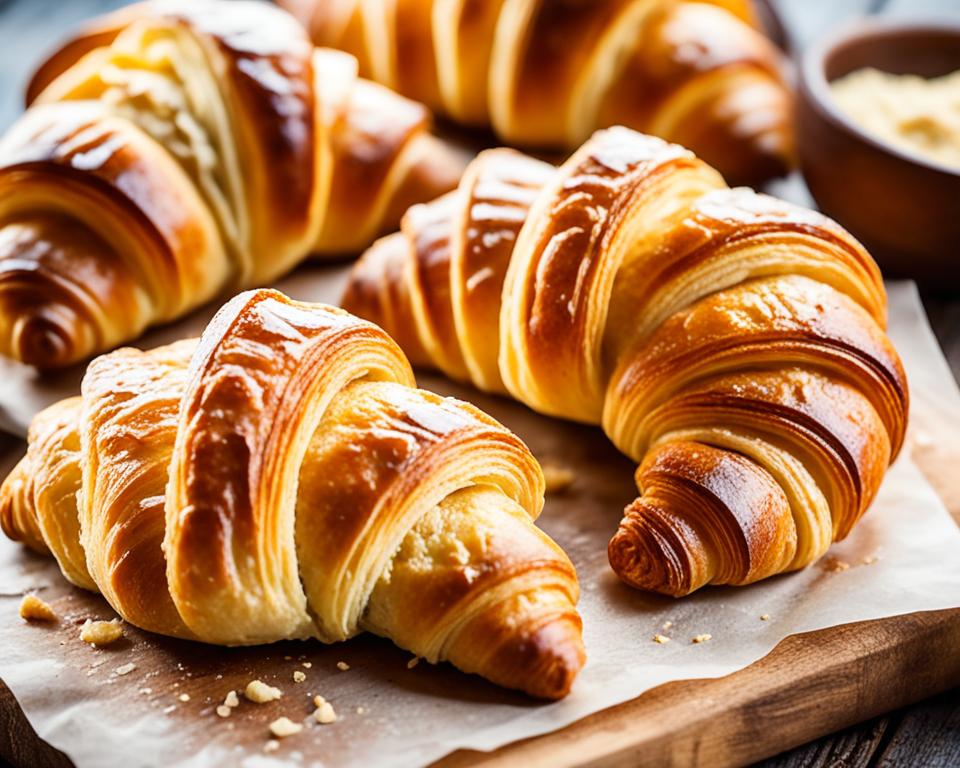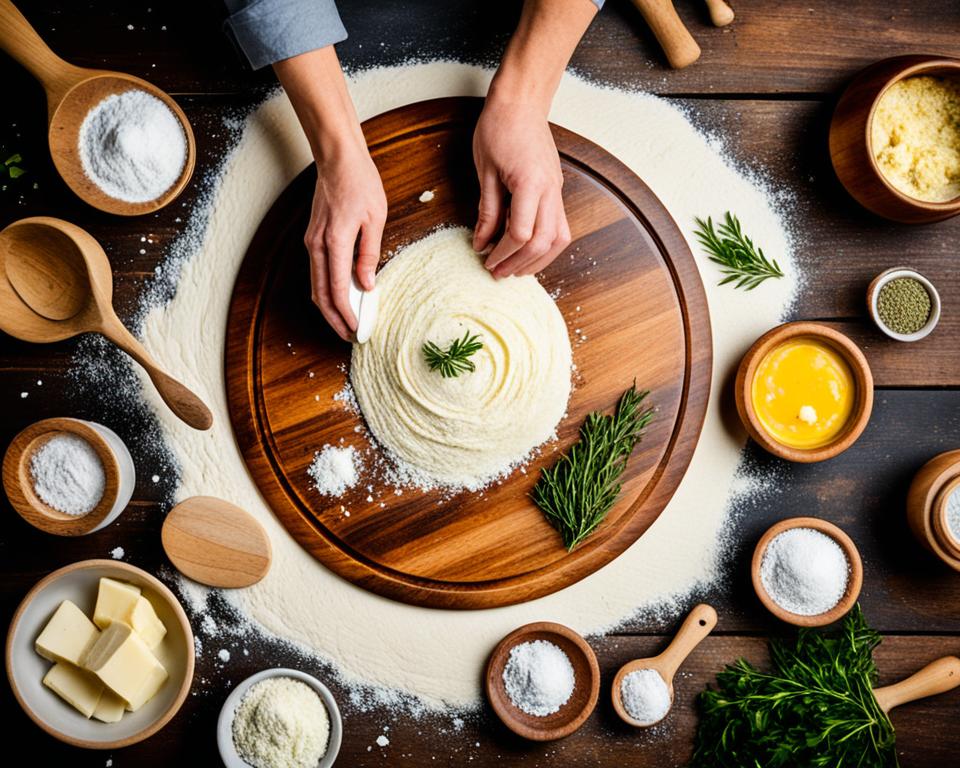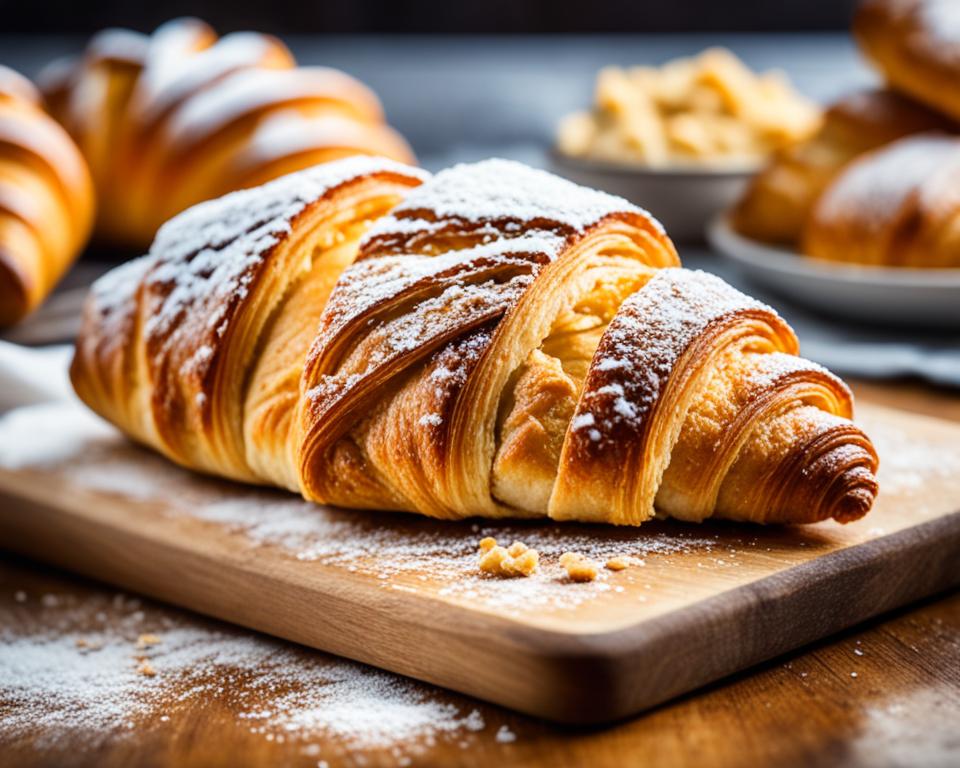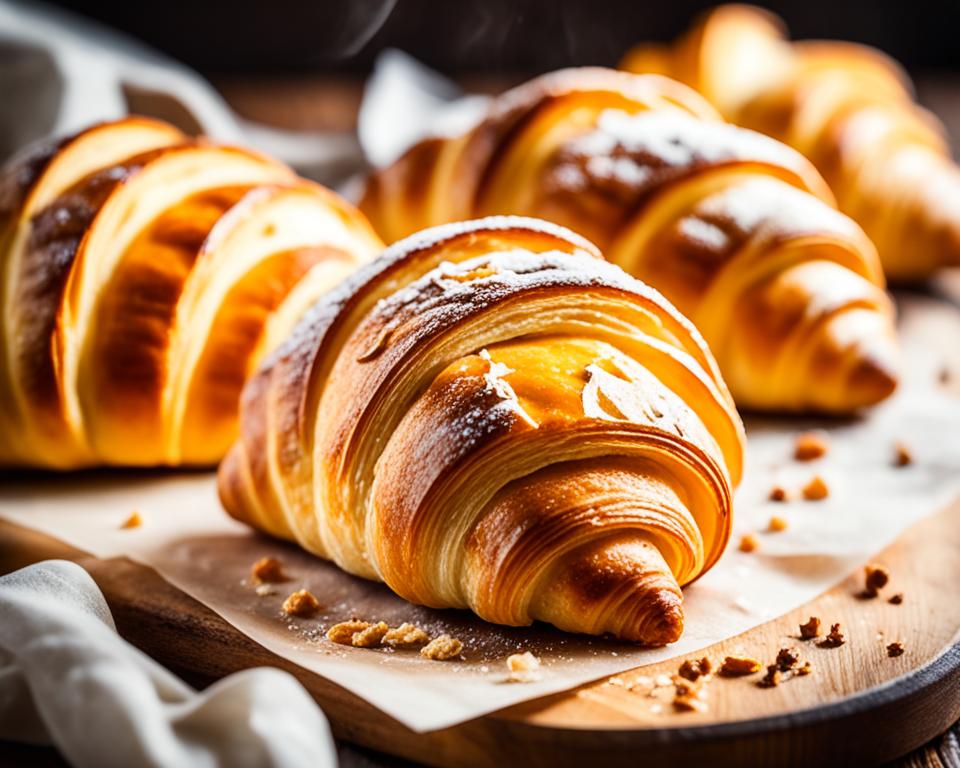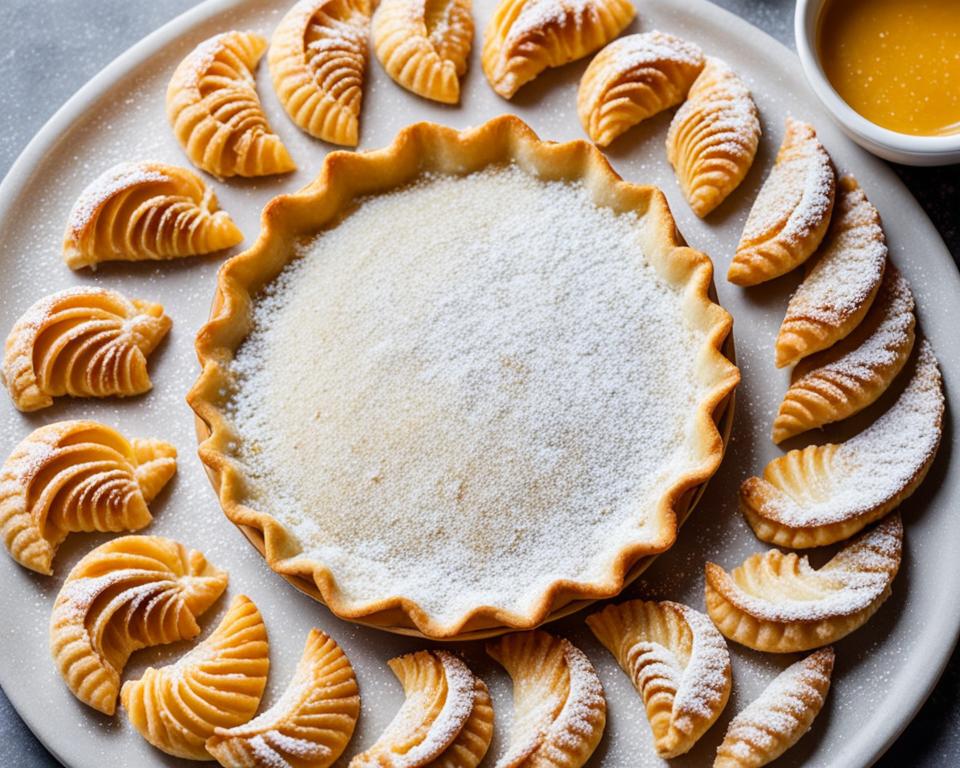The scent of buttery pastries baking in the morning is enough to stir any sleepyhead from their slumber. There’s something undeniably enchanting about pulling a tray of golden, delicious breakfast pastries from the oven—their flaky layers practically whispering promises of taste bud ecstasy.
For those who have indulged in the splendor of homemade croissants, there’s a shared understanding that these are no ordinary morning fare. They are a symbol of culinary dedication, a masterpiece of dough and butter intertwined, rising to the pinnacle of flaky croissants excellence. Each bite, airy and light, yet rich and satisfying, marks the start of a blissful day.
What once seemed a luxury reserved for expert bakers is now a joyful achievement for home kitchens across the nation. The pride taken in crafting such artisanal treats from scratch imbues breakfast time with a sense of accomplishment and grandeur. Indeed, these buttery pastries epitomize the glory of morning routines, transforming a simple daily ritual into an event worth celebrating.
Key Takeaways
- Homemade croissants bring a touch of artisanal luxury to any breakfast.
- The delicate flakiness of these pastries is achieved through diligent butter layering.
- Serving croissants that one has baked themselves can elevate the morning experience.
- Flaky layers in croissants symbolize culinary commitment and a successful baking endeavor.
- Enjoying homemade croissants is both a gratifying personal treat and an impressive addition to one’s hosting repertoire.
The Secret Behind Perfect Flaky Croissants
Achieving the pinnacle of pastry flakiness in croissants has much to do with a technique that artisans and baking enthusiasts revere: the meticulous integration of butter and masterful rolling and folding. For those eager to explore flaky pastry recipes and perfect their croissant-making skills, the secret lies not only in the quality and quantity of butter used but also in the execution of a specific folding method known in the culinary world as laminating.
The croissant baking tutorial begins with an understanding that butter–a seemingly extravagant ingredient–is the cornerstone of this dough’s character. When heated in the oven, the high water content in butter transforms into steam, puffing up the dough and creating pockets that result in tender, flaky layers. But achieving such levels of pastry flakiness doesn’t come without patience and practice.
The “tri-fold” is essential for creating those coveted multiple layers, and while it may sound simple, the key to its success is consistency. Each fold multiplies the layers, and with just three folds, you can significantly enhance the texture of your croissant, leading to a final product that boasts dozens of delicate, buttery sheets within.
“Once you master the tri-fold and respect the butter, you’re well on your way to creating croissants that rival those from the best French patisseries.”
Even without professional equipment such as dough sheeters, which are standard in commercial bakeries, buttery, flake-rich croissants can be realized in the home kitchen. It requires a commitment to the process and a willingness to learn from each batch. The home baker’s journey to flaky perfection is a testament to the craft of pastry making, nurturing both skill and knowledge with every sheet of dough rolled.
- Incorporate a generous amount of high-quality butter into your recipe.
- Carefully roll and fold your dough, ensuring even distribution of butter.
- Practice patience; rushing the process will not yield optimal flakiness.
While there are no shortcuts to creating the ideal pastry flakiness, the results—a tray of golden, buttery croissants—are a rewarding testament to the baker’s efforts. Whether you are a seasoned baker or a novice, every step you take brings you closer to mastering the art of the perfect flaky croissant.
Flaky Croissants: A Culinary Staple
Among the pantheon of French pastry, the croissant stands out as a timeless icon, the very essence of a rich culinary history that dates back centuries. These butter-laced baked goods do more than just tantalize the taste buds; they embody the craft and patience inherent in the tradition of French patisserie. With each layer, there lies the story of an evolving French pastry that has endured as a beloved indulgence across the globe.
The History of French Pastry
The chronicles of French pastry began in medieval times and flourished during the Renaissance, with the cross-cultural exchange of culinary practices shaping its legacy. Artisans dedicated their lives to perfecting techniques that would influence Western confectionery profoundly. Amidst this rich tapestry of innovation, the croissant emerged as a symbol of craftsmanship, a testament to the skill of layering and the delicate balance of flavors only a true maître pâtissier could achieve.
What Makes Croissants So Indulgent
What sets croissants apart as the epitome of French pastry is not just their crescent shape but what that shape encases—a multitude of indulgent, flaky layers. The secret to croissant’s irresistible allure stems from the meticulously orchestrated dance between the dough and the butter. This process, which includes the legendary laminating method, demands time and attention but results in a texture and taste unparalleled in the world of baked goods. It’s the balance of richness and lightness that solidifies the croissant’s place at the breakfast table, making it a staple for anyone who seeks an exceptional start to their day.
Exploring the Ingredients for Buttery Pastries
The art of crafting homemade croissants begins with a selection of essential ingredients. These components are simple, yet they combine to create an enriched dough that bakes into a masterpiece of both flavor and texture. When speaking of quality butter, this key player imparts not only richness and taste but also contributes to the airy layers that are characteristic of perfect pastry. Let’s delve into the makings of this buttery wonder and understand how each basic ingredient elevates the humble croissant to a culinary delight.
| Ingredient | Role in Croissant Making | Preferred Type for Optimal Quality |
|---|---|---|
| Butter | Provides flavor, and creates steam during baking for flakiness | High-quality, unsalted, European-style with higher fat content |
| Yeast | Catalyzes dough fermentation, allowing it to rise | Instant or Active Dry |
| Flour | Builds the dough’s structure | All-Purpose, for light and tender pastries |
| Sugar | Feeds yeast, adds flavor | Granulated |
| Salt | Strengthens gluten, enhances flavor | Fine, to evenly disperse |
| Milk | Enriches the dough, contributes to browning | Whole or 2%, for slight fat content |
| Egg (for brushing) | Gives a golden crust | Lightly beaten, possible addition of milk or water |
These foundational ingredients may seem commonplace, but their quality and the way they are brought together are anything but ordinary. Selecting the right type of flour, the perfect texture of butter, and the correct yeast is what sets apart a decent croissant from a remarkable one. It is this dance of base ingredients that lays the foundation for the sumptuous layers and subtle complexities of homemade croissants.
The joy of baking homemade croissants is in the alchemy of transforming humble staples into a stack of golden, flaky goodness. One can almost hear the soft sigh as a layer peels away from its brethren, the crisp exterior giving way to the tender heart of a well-made pastry.
Quality ingredients are the silent heroes in the narrative of croissant making. Without the support of quality butter, the ineffable charm of the enriched dough would not reach its full potential. This careful composition of elements results in a bounty of homemade croissants that emanate a warmth and comfort, heralding a new day with their irresistible aroma and unparalleled taste.

Homemade Croissants vs. Store-Bought
When it comes to enjoying delicious breakfast pastries, discerning baking aficionados often face a choice: to bake or to buy? The allure of homemade croissants lies in their freshness and the personalized touch that one can infuse into each batch, presiding over store-bought alternatives that might lack this bespoke charm.
The Freshness Factor
Fresh out of the oven, the sensory appeal of homemade croissants is undeniable. From the golden crust to the aroma that fills the kitchen, the experience of baking your own flaky croissants is unparalleled. Store-bought versions, while convenient, struggle to match the vivacity and warmth of their just-baked counterparts.
Customizing Your Batch
Those who embark on creating their own batches of fresh baked croissants understand the beauty of customization. Whether it’s shaping the dough to create the perfect curvature or adding fillings of choice, each croissant becomes a unique expression of culinary artistry, tailoring delicious breakfast pastries to personal or family preferences that store varieties simply cannot offer.
| Feature | Homemade Croissants | Store-Bought Croissants |
|---|---|---|
| Freshness | Just-baked, with all the irresistible qualities of freshness | Varies; may be baked hours or days prior |
| Customization | Personalized fillings, sizes, and shapes | Limited options, standardized offerings |
| Texture & Flavor | Buttery, tender layers flavored to preference | Consistent but may lack homemade charm |
| Experience | A rewarding baking adventure and opportunity to learn | Convenient to purchase but lacks the personal touch |
Tips for Achieving the Perfect Pastry Flakiness
If you’re diving into a croissant baking tutorial, one of the most crucial aspects you’ll need to master is achieving the trademark pastry flakiness that makes for flaky croissants. It’s a skill that demands patience and precision, but with these expert tips, you’ll be well on your way to creating a breakfast delicacy that rivals those found in the best cafés.
Firstly, it’s essential to understand that temperature control is vital. The butter used in the dough must remain cold; otherwise, it will absorb into the dough instead of creating the distinct layers necessary for flakiness. Therefore, refrigeration between each ‘turn’ or fold of the dough is non-negotiable. Secondly, handling the dough in cool conditions, such as an air-conditioned room or early in the morning when temperatures are lower, can significantly help maintain the texture of the butter within the dough.
The type of flour also plays a significant role in the outcome of your croissants. While bread flour is excellent for chewy bread, all-purpose flour is the go-to for light and tender croissants, as it develops less gluten. Higher gluten content can lead to a tougher pastry, which is not what we aim for with delicate, flaky croissants.
In the world of baked goods, not all butters are created equal. A high-quality butter with a higher fat content makes a considerable difference, providing rich flavor and contributing to the desired flakiness of your croissants. Remember, the quality of the ingredients often determines the quality of the final product.
“Freshly baked croissants, with their light and airy layers, are not an everyday indulgence—it’s an art that requires fine ingredients, precise technique, and, above all, patience.”
To help you remember these tips, here’s a compact list:
- Use cold butter: Essential for achieving flaky layers.
- Maintain cool temperatures: When handling the dough, cooler is better.
- Select all-purpose flour: Bread flour’s high gluten content can lead to tougher pastries.
- High-quality butter: A good, flavorful butter enriches the overall sensory experience.
- Freshly baked enjoyment: Flaky croissants are best enjoyed the day they are made.
Adhering to these principles not only assists in creating the perfect pastry flakiness, but it also turns the process into an enjoyable journey through the intricacies of baking. It’s the combination of best practices and fine ingredients that allows the home baker to achieve the heavenly texture and taste associated with classic French patisserie.
For your next baking session, keep these tips in mind and take pleasure in the process. Once you’ve reached flaky perfection, you’ll find that all the folding, chilling, and patient waiting are well worth the effort. Whether it’s for a leisurely Sunday brunch or a quick weekday breakfast, your homemade croissants will brighten any morning with their buttery, flaky splendor.
Mastering the Art of Laminating Dough
The allure of buttery pastries, particularly the famed croissant, starts with a process central to their creation—laminating dough. This skill is not merely about mixing and rolling; it’s a nuanced art that, when perfected, encapsulates the essence of a true French pastry. It’s essential to understand the elements involved in laminating dough to replicate the quality and texture beloved in these classic baked goods.
Understanding the Butter Block
To initiate the lamination process, one must begin with the butter block—a crucial component that, when folded into the dough, creates the separate layers leading to the flaky texture of croissants. The butter block is forged by combining butter with a touch of flour and then refrigerating until it achieves a malleable consistency that complements, rather than competes with, the dough’s elasticity.
Technique: Rolling and Folding
Once the butter block has chilled, it is enveloped in the dough through a careful technique of rolling and folding. Typically, this is accomplished by executing a series of ‘turns’, a diligent method of rolling out the dough and folding it over the butter. This process, repeated multiple times, results in the even distribution of butter and contributes significantly to the stratified structure of the dough—crucial for achieving the flakiness associated with a luxurious French pastry.
- Roll out the dough into a rectangle, place the chilled butter block on top, and fold it to encase the butter fully.
- Rotate the dough 90 degrees, and roll out gently to maintain the layers without causing the butter to ooze out.
- Perform the first ‘turn’ by folding the dough into thirds, wrap in plastic, and chill to maintain consistency.
- Repeat the rolling and folding process two more times with resting periods in between to build the classic, intricate layers.
The journey through the layers of a croissant shouldn’t end at the baker’s counter—it is an invitation to home bakers everywhere to embark on a path to achieving the golden, flaky croissants traditionally found in French bakeries. By mastering the butter block and refining the technique of rolling and folding, one can bring the unparalleled experience of freshly baked buttery pastries to any kitchen.
Your Guide to Baked Goods: Croissant Baking Tutorial
There’s nothing quite like the aroma and taste of freshly baked, homemade croissants. With layers that are at once buttery-rich and feather-light, these pastries are the crowning glory of baking skills. This step-by-step croissant baking tutorial will guide you through the meticulous process of creating your own luxurious layers of perfection. For this culinary adventure, you’ll require some specific baking equipment to ensure the best possible results.
Preparing Your Dough
Starting with the basics, the preparation of croissant dough is a ritual that sets the stage for the final product. To begin, gather your ingredients – making sure your butter is cold and your stand mixer is at the ready. Combine these quality inputs in the mixer and let the dough hook work its magic. Patience here is key; giving the dough ample time to proof is essential for the development of flavor and texture. A tip for the uninitiated: don’t skimp on the proofing time! A well-proofed dough paves the way for homemade croissants that are superior in both taste and structure.
Laminating with Precision
With your dough now doubled in volume and infused with potential, it’s time to laminate. This process, where butter meets dough in a harmonious union, demands precision. Begin with your chilled dough and a well-floured surface. Layering requires a rolling pin, parchment paper, and baking sheets – pieces of baking equipment that are non-negotiable for any croissant aficionado.
Roll the dough out, place a sheet of parchment paper on the baking sheet, and set your dough atop. The first fold is just the beginning; you’re embarking on a journey of creating a multitude of flaky layers. Each turn, fold, and roll is an iteration in crafting the intricate flakiness that defines a noteworthy croissant. Remember to refrigerate the dough after each fold to ensure the butter remains cold. Overnight refrigeration will not only solidify these layers but also give rise to nuanced flavors that fully blossom only when the pastries are baking. What emerges from the oven will not just be a test of your baking prowess, but a batch of homemade croissants to rival any bakery’s best.
With a careful eye and a steady hand, your journey through the rewarding world of pastry making is underway. Following this croissant baking tutorial will undoubtedly enhance your prowess with baked goods, taking you one step closer to achieving breakfast bliss.
The Role of Patience in Baking Delicious Breakfast Pastries
The creation of delicious breakfast pastries such as homemade croissants transcends mere culinary skill—it is a testament to the virtue of patience. The nuanced layers and airy texture of a classic French pastry stem from not only the quality of ingredients but also the dedication to slow and attentive preparation—elements that cannot be hastened without compromising the end result.
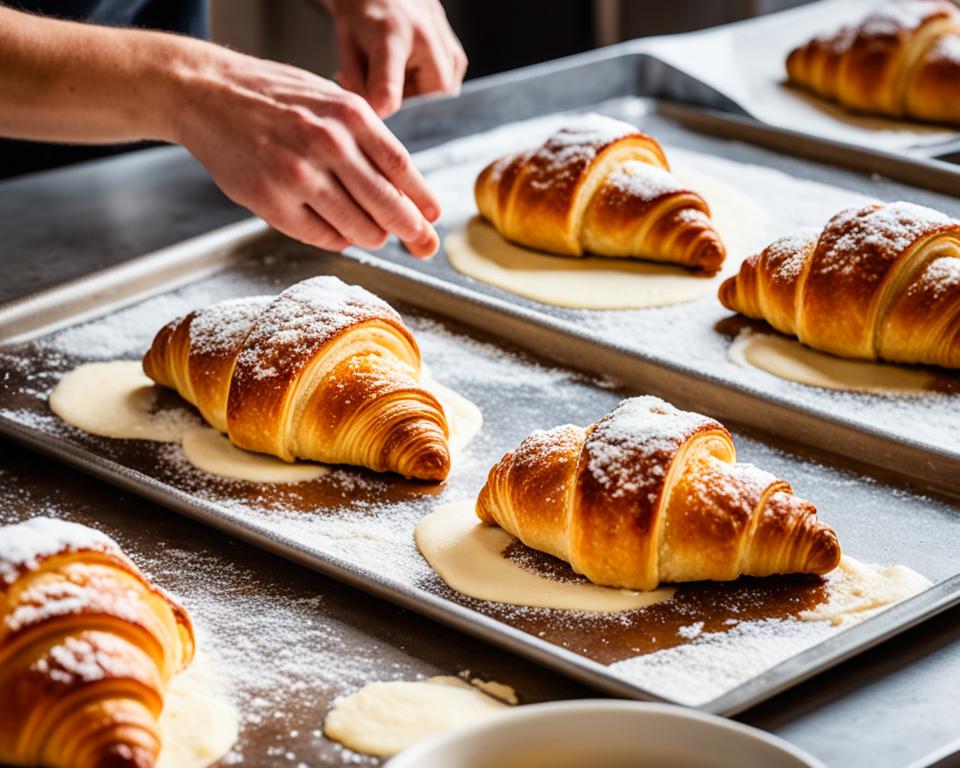
In the realm of baking, especially with regard to French pastry, patience is both an ingredient and a tool. It begins with the leisurely incorporation of butter into flour, followed by the crucial steps of chilling and resting the dough. Each of these moments in the process of crafting homemade croissants contributes to the pastry’s flaky excellence and must be met with the care of a devoted baker.
Patience is further called upon during the proofing of the dough, a time when the artist must step back and allow warmth and time to coax the yeasted dough into its full volume and potential. This stage cannot be abbreviated without foregoing the croissants’ signature texture—that perfect balance of crunch and softness that has solidified its status among the most revered delicious breakfast pastries.
True patience in pastry-making yields a feast not just for the taste buds but for all the senses, resulting in homemade croissants that are both a visual delight and a textual wonder.
- Allowing the dough to chill thoroughly between folds to ensure delicate, buttery layers
- Providing the dough ample time to rest, deepening the flavors and contributing to the croissants’ magnificent rise
- Proofing the shaped croissants until they puff up, light and ready for their final transformation in the heat of the oven
The process of creating French pastry, and in particular the flaky croissants that are the jewel of the breakfast table, is thus a gentle reminder in the fast-paced modern world that some things are worth the wait. Those who indulge in these homemade croissants, crispy on the outside and whisper-soft within, are enjoying not just a pastry, but the rich rewards of a patient and attentive baking philosophy.
Creating Layers of Flavor: The Butter Factor
The magic behind buttery pastries doesn’t begin with sophisticated mixers or exotic ingredients; it starts with the foundation of all pastry flakiness—the butter. The journey to creating pastries that sing with flavor and texture is hinged wholly on the quality of butter chosen by the baker. It’s a simple truth: superior butter elevates good pastry to greatness.
There is a palpable difference between a good croissant and a great one, and often, that difference is the butter. When it comes to quality butter, discerning bakers look for options with a higher fat content, which promises to impart a rich, unmistakable flavor and the ideal foundation for flaky pastries that shatter delightfully with each bite.
Choosing the Right Butter
The art of turning regular dough into an extraordinary croissant lies in the selection of quality butter. For those aiming to create an authentic replica of the classic French delight, European-style unsalted butter is king. Its high fat content—usually upwards of 82%—contrasts with the 80% of regular butter, making for a vastly different outcome when laminated into dough.
But the realm of buttery pastries is a broad church, and while European-style butter is often lauded as the finest, the goal should always be to use the best available within your means. A key tip for home bakers is to ensure the butter is unsalted, granting full control over the flavor profile of your flaky creation.
The Science of Butter and Steam
Understanding the chemistry of butter in the making of pastry flakiness is to unlock one of the foundational secrets of pastry craft. As butter melts during the baking process, water trapped within turns to steam, aggressively expanding and pushing the dough upward and outward—this steam gives rise to the croissant’s signature flaky interior and crisp exterior.
The quality of butter comes into play here, as higher quality options have a lower water content, subsequently offering a more predictable steam release and an even, satisfying texture. Acquaintance with this principle reveals why a slab of quality butter tucked into dough is not so much a suggestion as it a non-negotiable rule for the dedicated baker.
In conclusion, for those captivated by the allure of perfect buttery pastries and the quest to achieve them, the butter factor cannot be understated. From the selection of high-fat content butter to understanding butter’s role in creating steam, each aspect coalesces to construct the flawless croissant, embodying a mastery over both taste and texture that marks the pinnacle of pastry making.
The Rewards of Homemade Flaky Croissant Recipes
The journey of creating homemade croissant recipes culminates in the sheer delight of savoring each flaky layer—a labor of love that is evident with every bite. It’s about more than just crafting a baked good, it’s about invoking the joy of baking and the pride that comes from sharing your handmade creations.
Serving Suggestions to Enhance Enjoyment
Enjoyment of these delicate, flaky croissants can be elevated with just a few thoughtful touches. Imagine a table laid with freshly baked croissants, a selection of fruit jams, and a pot of rich, aromatic coffee—a setting that promises to start any day off right. For those seeking to indulge in their sweet tooth, a drizzle of honey or a sprinkle of powdered sugar can transform the simple croissant into a decadent treat. Ample consideration goes into pairing these pastries with accompaniments that complement their buttery richness.
The perfect homemade croissant is versatile; it can be the base for a variety of more elaborate offerings, such as almond croissants or sandwiches stuffed with savory fillings. The satisfaction of pulling apart a croissant to reveal its airy interior, paired with a layer of almond cream or a slice of ham and cheese, transforms a simple pastry into an unforgettable gourmet experience.
Sharing the Bliss with Family and Friends
Perhaps the truest joy in mastering homemade croissant recipes lies in the act of sharing these baked goods with others. There’s a unique pleasure in observing the expressions of delight as loved ones unravel the layers of your flaky creations. It’s not just sharing a meal, but an experience, making each gathering around a tray of croissants a cherished moment. Inviting family and friends to partake in this sensory delight turns any gathering into a festive celebration, reinforcing the timeless adage that good food brings people together.
- Freshly baked croissants are best paired with jams, honey, or powdered sugar.
- They can serve as a canvas for both sweet fillings like almond cream and savory options such as ham and cheese.
- Sharing croissants with loved ones multiplies the enjoyment, making every breakfast a special occasion.
Ultimately, the art of baking—and particularly the crafting of flaky croissants—is enriched by the memories created and the bonds strengthened over these masterful homemade baked goods. Each golden crescent is a testament to the warmth and connection that only home cooking can engender.
Necessity of Quality Ingredients for Flaky Pastries
In the realm of buttery pastries, the supremacy of high-caliber elements stands undisputed. Each component chosen bears weight, shaping the delicate balance of flavors and textures that are hallmark to a French pastry. Exemplifying culinary finesse, the art of creating flaky pastries is contingent upon quality ingredients that bestow each layer with richness and depth. It’s a simple culinary truth: the pedigree of your pastries pivots on the purity of your provisions.
A quintessential French croissant isn’t just a baked good—it’s a symphony of ingredients that, when composed with care, create a form of edible architecture. The distinction between a pleasant pastry and a palate-revering experience often lies within the foundational building blocks—a narrative of high-quality fats, refined flours, and fresh leavening agents.
“Every bite of a French pastry not only speaks to the skill of the baker but also to the caliber of ingredients used—a reflection of excellence from beginning to end.”
To elucidate the profound influence of ingredients on the creation of superior croissants, consider the following table, highlighting the indispensable role each element performs in actualizing the iconic texture and taste of these cherished pastries.
| Ingredient | Function | Quality Benchmark |
|---|---|---|
| Butter | Key player in laminating, provides flavor, and creates steam for lift | European-style, high butterfat content, unsalted |
| Yeast | Fermentation agent, imparts rise and a nuanced depth | Fresh, active, resilient strains capable of sustained leavening |
| Flour | Structural support, impacts texture profoundly | Unbleached, all-purpose for tender crumb; precise sifting and blending |
| Sugar | Feeds yeast, imparts subtle sweetness | Pure, fine granulated for even distribution and balanced flavor |
| Salt | Flavor enhancer, tightens dough structure | Sea salt or mineral-rich varieties for complexity |
| Milk | Enriches the dough, aids in browning and flavor | Fresh, whole milk for richness; alternative varieties for dietary preferences |
| Eggs | Binds ingredients, adds color and richness | Organic, free-range with vibrant yolks for superior taste and texture |
By adhering to these benchmarks, one can begin to decipher the tapestry of taste housed within a buttery, flaky pastry. The devotion to selecting premium ingredients echoes a commitment to excellence, a covenant that ensures each flake and fold resonates with the richness and heritage of age-old French pastry traditions.
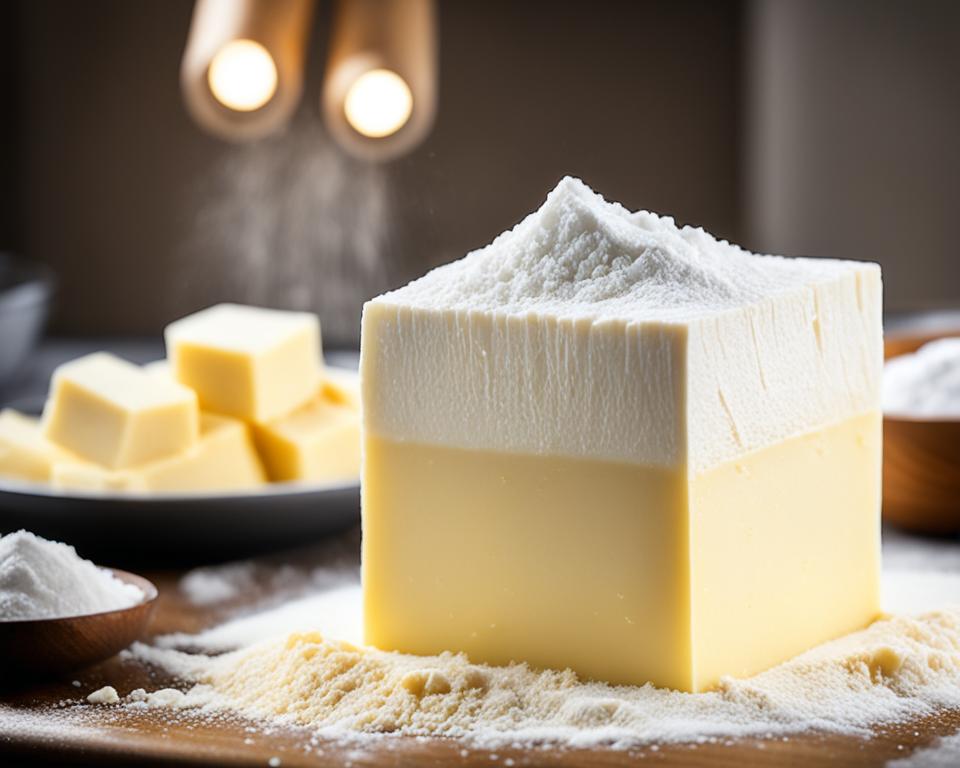
A marriage of quality and tradition gives birth to pastries that not only carry the weight of the baker’s touch but also the essence of the ingredients’ origins. And so, the quest for creating sublime flaky pastries enriches not just the croissant but the very essence of the culinary arts—the relentless pursuit of a mastery defined by the purity of its components.
Your Breakfast Bliss: From Preparation to Presentation
Embarking on the journey to create the ultimate buttery pastries culminates in a moment where all senses converge—the presentation of your golden, fresh baked croissants. It’s here, in the final reveal, that the craftsmanship of flaky layers and scrumptious aromas are fully appreciated. Serving these delicious breakfast pastries straight from the oven is critical, as the warmth magnifies the flavors and textures, crafting an immersive breakfast experience.
Baking a Golden Brown Treat
Whether for an intimate weekend brunch or a bustling weekday morning, achieving a flawless golden brown color on your croissants is pivotal. This browning is a visual and taste-signaling hallmark of perfectly executed buttery pastries, telling you and your eager guests that what awaits within is a cloud of flaky, airy, butter-laden perfection. Monitoring them closely as they bake is the key to ensuring each croissant reaches this pinnacle without straying to overdone.
The Final Touch: Serving Your Croissants Fresh
Nothing compliments the morning’s first sips of coffee like a side of fresh baked croissants. This marriage of rich, aromatic java and warm, fluffy pastry elevates morning rituals to a celebration of new beginnings. The quintessential croissant, served fresh and complemented by a selection of preserves or simply a brush of melted butter, realizes the vision of breakfast bliss. Each croissant becomes a token of a day started with intention, pleasure, and exquisite taste.
FAQ
What are the key ingredients needed to make homemade flaky croissants?
The essential ingredients for making homemade flaky croissants include unsalted butter, instant or active dry yeast, all-purpose flour, granulated sugar, salt, milk, and an egg for brushing the tops of the croissants.
How does the butter content affect the flakiness of croissants?
The water content in butter turns into steam during baking, which separates the layers of dough, creating the croissant’s signature flakiness. High-quality butter with a higher fat content is preferred as it provides better texture and flavor to the pastry.
Can you make croissants with the same flaky quality at home without professional equipment?
Yes, it’s possible to achieve buttery, flaky croissants at home by closely adhering to the techniques of dough lamination and ensuring conditions are cool enough to prevent the butter from melting prematurely. While professional dough sheeters could ease the process, a rolling pin and careful handling can produce excellent results at home.
How important is the lamination process when making croissants?
Lamination is critical to creating the multiple layers that result in flaky croissants. This involves a series of rolling and folding the dough with a butter block, which evenly distributes butter throughout and multiplies the layers of dough for that characteristic texture.
What are the benefits of making croissants at home compared to buying them from the store?
Homemade croissants offer unparalleled freshness and the opportunity for customization. The sensory experience of enjoying a croissant straight from the oven is something store-bought versions usually cannot match, and baking them at home allows for adjusting sizes, shapes, and fillings to personal taste.
Why is it recommended to use all-purpose flour instead of bread flour for croissants?
All-purpose flour is recommended over bread flour for making croissants as it typically has a lower protein content, resulting in a softer and lighter crumb which is ideal for achieving the tender layers in a croissant.
How is the historical significance of French pastry reflected in homemade flaky croissants?
French pastry, known for its sophistication and indulgence, is reflected in the intricate process of making flaky croissants, which are a staple of French baking. The commitment to a meticulous process and high-quality ingredients echoes the rich culinary traditions of French pastries.
What is the butter block and why is it important in making flaky pastries like croissants?
The butter block is a mixture of butter and a bit of flour, which is chilled and then wrapped within the rolled-out dough. It is essential as it ensures the butter is evenly distributed through the layers of dough, which is vital for achieving the light and flaky texture of the pastry when baked.
How long should croissants be proofed and why is this step important?
Croissants should be proofed until they have visibly increased in size and appear puffy. This step is important as it allows the yeast to ferment and the dough to rise, creating the airy texture that is a hallmark of properly baked croissants.
What is the best way to serve homemade flaky croissants for maximum enjoyment?
Homemade flaky croissants are best served fresh from the oven, when they are most crispy and tender. To enhance the enjoyment, pair them with a selection of jams, honey, or chocolate spreads, and complement with a cup of coffee or tea for a delightful breakfast or snack.
Can I use salted butter instead of unsalted butter for making croissants?
It’s recommended to use unsalted butter for making croissants to better control the amount of salt in the recipe. However, if salted butter is all you have, you can use it and reduce the additional salt called for in the recipe accordingly.
What is the significance of letting the dough rest overnight in the croissant baking process?
Letting the dough rest overnight in the refrigerator is significant as it allows the gluten in the dough to relax, making it easier to roll out. This period also gives the dough time to develop deeper flavors and ensures the butter stays cold, which is essential for successful lamination.

